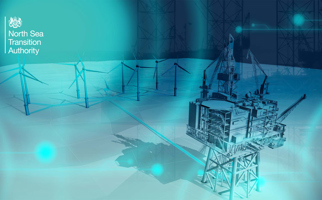
Stuart Payne, the NSTA's Chief Executive, remotely delivered a speech and presentation titled, "CCS – Why it matters and why what you are all doing really matters", on 5 October 2023 at the CCUS Conference, hosted by the Society of Petroleum Engineers' Aberdeen Section and the Geoscience Energy Society of Great Britain. Read the speech below and view the presentation here.
Intro
[TITLE SLIDE]
Good morning everyone, it’s a pleasure to be here today opening day 3 of your conference.
I’m Stuart Payne, Chief Executive of the North Sea Transition Authority.
I’ve worked in the oil and gas industry my whole career, but unlike most of you I am not a petroleum engineer, chemical engineer or geoscientist, so speaking to the you all today is a privilege if not a little daunting.
Whilst I’m not a technical expert, the good news is that there are a number of NSTA colleagues with us today who very much are.
So my job, both here, and every day, is not to get into the detail, but to zoom out and look at the bigger picture of why our work on CCS is so vital and how it fits into the broader energy transition conversation.
NSTA
[SLIDE 2 – NSTA]
Firstly the NSTA – who are we, what do we do and why do we matter to your work?
The NSTA exists to maximise the potential of the North Sea, both as an energy and carbon abatement resource and to realise the huge economic opportunity it offers the UK.
We have three key priorities, three pillars, all playing an equal role in delivering on those aims. Energy security, emissions reduction and accelerating the transition.
Energy security is underpinned by the existing and future domestic oil and gas production this country will continue to rely on to help meet our energy needs.
I suspect this audience will know this very well already but we regularly have to remind ourselves, and others, that oil and gas meet three quarters of the UK’s energy demand today and are forecast to meet between a fifth and a quarter of demand even in 2050.
I hope that the 33rd offshore licensing round we are currently running will contribute new developments to help meet that demand.
These projects also matter for CCS.
The technical expertise that delivers oil and gas projects is of course the foundation for delivering on carbon storage, the same engineers and geoscientists are needed for both.
The supply chain companies who supporting drilling, manufacture and install pipelines, operate and maintain large offshore structures in the oil and gas industry have the technology and equipment which will be required to do carbon storage.
If we let go of our oil and gas industry too soon, we risk losing the Kit, Capability and Capital of the industry before they can deliver on carbon storage.
If that happens, we will still have a carbon storage industry, but it would risk being smaller, it could take longer, and be much more reliant on imported capability. Most importantly it won’t provide the same career opportunities or economic bounty for the UK.
The second pillar - emissions reduction, is part of this same picture. If industry does not reduce its operational emissions they risk sacrificing their social licence to continue operating in the UK basin – with the same consequences and loss of capability.
The NSTA has a laser-sharp focus on regulating industry to ensure energy is produced as cleanly as possible. Just today we launched a plan to put new requirements on the sector to do more to cut its carbon footprint.
These two priorities – helping to maintain an ever cleaner domestic oil and gas sector are essential to delivering on the last priority - accelerating the transition.
This is where our work on CCS and, since last week, hydrogen is focussed.
The key word is accelerating. We have to do this at pace. We are in a race. A race to reach net zero by 2050, a race to attract the global capital needed to finance the transition and a race to attract and retain the talent that can make it happen.
CCS – what we need and why it is possible
[SLIDE 3 – CCS]
Let’s be clear CCS is absolutely essential to the UK meeting its net zero targets. There is currently no credible pathway to reaching net zero without it.
These two graphs show the UK’s domestic carbon storage requirements to meet the 2050 targets.
Under the Climate Change Committee’s balanced net zero pathway we will need to have stored a cumulative total of 1.6 GT of CO2 by 2050.
The good news is the UK more than has enough capacity – a potential 78GT in the UKCS – centuries worth of UK emissions and, if you are into such comparisons, the equivalent of 132 million flights around the Earth.
We all know that there is the potential that we may be able to ‘export’ some of this capacity to industry in other countries,– but first we must get our domestic industry off the ground.
To achieve our storage targets we need to ramp up to an injection rate of 100 megatonnes of CO2 a year by 2050.
If progress decarbonising other parts of the economy is slower than hoped we could need to deliver 180 megatonnes a year
There are checkpoints along the way with interim Government targets to be storing 20 to 30 megatonnes a year by 2030.
What does this mean in terms of actual offshore stores?
The NSTA estimate the UK needs to have appraised up to 100 carbon stores by 2050. This will be more than we ultimately need but accounts for store or project failures.
So that’s the headline goal - 100 appraised stores, with at least 100 megatonnes of CO2 injected a year by 2050.
How are we doing?
[SLIDE 4 – PACE IS KEY…]
Well right now in the UK we have FOUR fully appraised stores and are injecting 0 MT of CO2. We all recognise the reality that we are on the starting line of the race.
Even with the existing projects under licence there is big potential capacity gap.
And to deliver the required capacity we estimate we could need potentially 120 new injection wells – the equivalent of nearly 30 years-worth of rig activity.
That leaves a hell of a lot of work over the next three decades, which is both a huge opportunity for the supply chain and a huge challenge to deliver.
There may be many in this room who look at the gap between where we are now and where we need to be and think ‘impossible, it can’t be done’.
Well, consider this.
The first licence for UK North Sea exploration was handed out in 1964. First gas came onstream in 1967, and first oil only in 1975. Just 24 years later – a shorter timeframe from now to 2050 - production peaked at 4.4 million barrels per day.
If at the start of the 1970s there had been a target to produce 30 Billions barrels of oil and gas by the turn of the century, people would have said the same – ‘impossible, it can’t be done’.
And yet, led by iconic fields, the names of which are now etched in the industry’s story – Forties, Brent, Ninian that is exactly what was delivered .
There are now around 300 fields and over 200 platforms operational in the North Sea.
An enormous and rapid achievement, made possible by brilliant people and incredible technological breakthroughs.
What that oil and gas success story bestows on us is an eco-system of technical know-how which gives us a head-start in carbon storage.
Of-course that doesn’t mean that we have all the answers. Like any great adventure, there remains plenty to be discovered, and much to be understood.
For example, the level of “corporate memory” regarding depleted reservoirs is completely different to the questions that remain in terms of saline aquifers – where around 85% of our estimated capacity sits.
That same curve of development and learning needs to happen again.
We are at the start of this new story and we, you, get to write the scripts, so that in 50 years people will look back just as proudly at the iconic names of the largest carbon stores in Europe.
Why Pace Matters and How We Find It – Failing Fast
Just like oil and gas though, we need to make sure that safety for our people, and care for our environment are baked into everything we do.
If I was being provocative, I’d say somewhere where we can probably do better than we have done in the past with oil and gas is to get used to failing fast. Pace, collaboration and sharing of knowledge will be vital.
[SLIDE 5 – NSTA ACTION]
The NSTA is playing its role and last month announced the recipients of 21 new carbon storage licences in the UKCS, from the world’s first, mass carbon storage licence round.
A massive achievement of which our whole organisation and indeed whole industry can be proud.
The work programs for these licences will all be visible in a few weeks on the NSTA website.
Just as with oil and gas licences the storage licences have planned timings for each phase of activity.
The NSTA will be encouraging operators, where appropriate, to be even more ambitious on the pace of the appraisal activities.
If stores are deemed unsuitable then industry must move quickly onto the next one to keep the pipeline of capacity coming.
Of course, I recognise as a regulator that the ability to ‘fail fast’ does not sit exclusively with industry.
Concerns over the certainty or type of business models can lead to delays in progressing projects.
Getting the necessary consents and approvals in a timely and consistent manner from a wide range of different authorities can be confusing, again leading to delays.
The NSTA is alive to these concerns and is working closely with central government, Ofgem and multiple other regulators to identify ways to streamline processes and provide clarity.
DESNZ will be publishing their CCS Vision later this year and we are actively engaging on this with them.
This is a new industry and we are all learning as we go. If there are issues you identify in the regulatory process please let my team know and we will do our best to solve them.
Zoom out
This matters from a narrow CCS point of view but it also matters when looking at the broader offshore energy transition.
CCS is a vital component of the transition, but it is only one part, and it is going to be delivered in what is becoming an increasingly crowded UK sea.
[SLIDE 6 – RUBIK’S CUBE]
For those of you who attended Offshore Europe last month you would have seen me talk about the Offshore Energy Rubik’s cube. The concept is simple.
Each colour of the cube represents a different offshore sector.
Oil and gas, offshore wind, CCS and hydrogen. Then there are other uses of the sea like the fishing industry, defence, and environmental protection. In the future technologies such as wave and tidal energy which are yet to be deployed at scale will be part of the mix.
This matters because we need all of these elements, or colours, to deliver both the UK’s energy needs and its net zero targets.
Crucially we need to deliver them all at once, in a co-ordinated fashion– we won’t solve this particular cube by only focusing on one colour at a time.
That is an enormous amount of activity, infrastructure and work in one small-crowded sea.
The carbon storage industry can’t afford to sit on huge areas of seabed, not progressing projects which may be needed for other, equally important users.
Whether it’s through technological breakthroughs, spatial planning reform, cross-sector collaboration or a combination of all we must find a way to make carbon storage work as part of an integrated energy basin.
Conclusion
Because there is no net zero without CCS, this means there is no net zero without you in this virtual room.
[SLIDE 7 – CCS YOU CAN MAKE THIS HAPPEN]
You get to be at the forefront of resolving literally the challenge of our times. When you’re frustrated, when you’re having a mediocre day at the office, please just take 30 seconds to reflect on the position you find yourselves in today.
The UK has a brilliant opportunity to be a global leader in one of the industries of the future.
Only the US has more planned carbon storage capacity than the UK, which means just as with oil and gas – a strong UK means a strong global industry.
The UK’s oil and gas legacy means we have so many of the things we need to make a success of CCS.
Let’s keep the good parts of that legacy – a strong focus on safety, ambition and pioneering spirit, courage to innovate, and a willingness to invest in the long term future.
But let’s also learn from where things can always be improved – better commercial behaviours, more collaboration, inclusivity and of course willing to fail fast and learn quickly.
I said at the beginning that my career in oil and gas is not a technical one. I didn’t say what it is. My career has been spent working to find, develop and retain great people. People ultimately are what makes the difference to a successful organisation or unsuccessful one.
It will be people like all of you in this room who get to decide whether this transition is successful or unsuccessful. That is exciting and a huge privilege.
Don’t lose sight of the bigger picture – because what you do matters.
END
Please note - There may have been some slight variations in the delivery of this speech.


